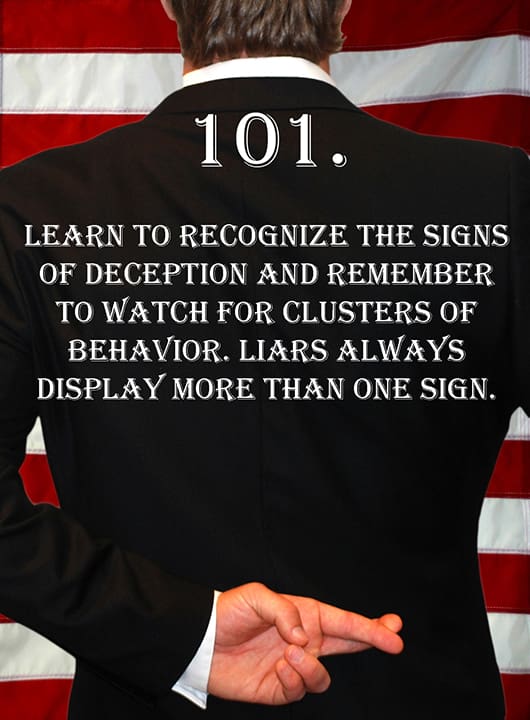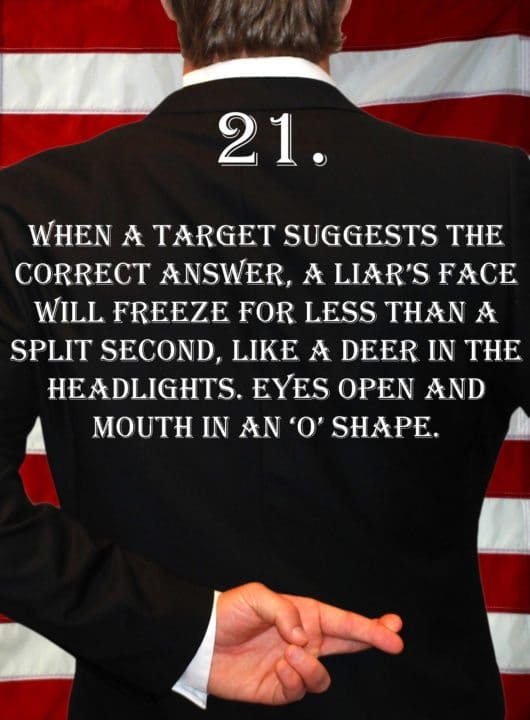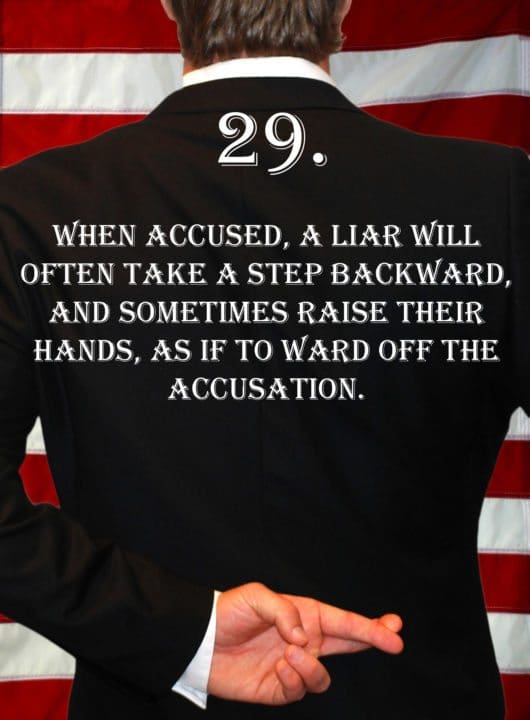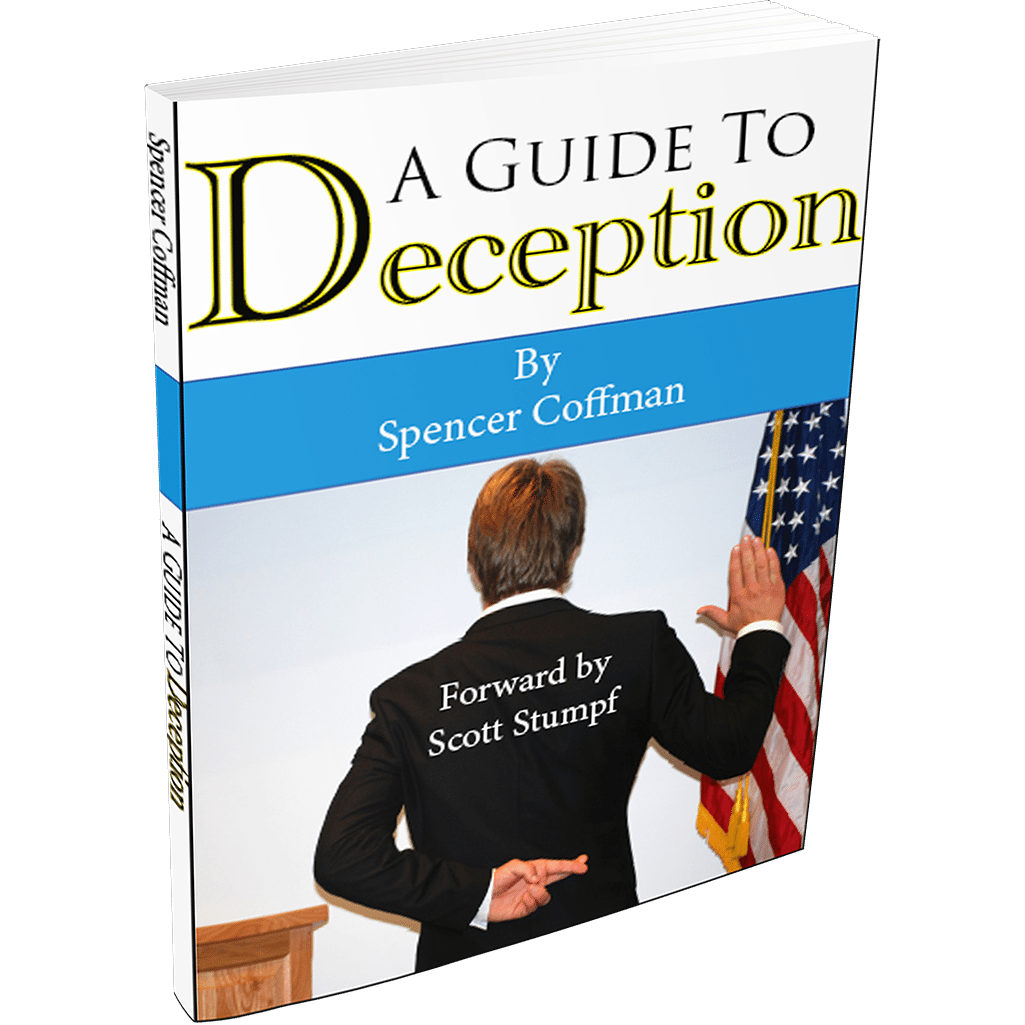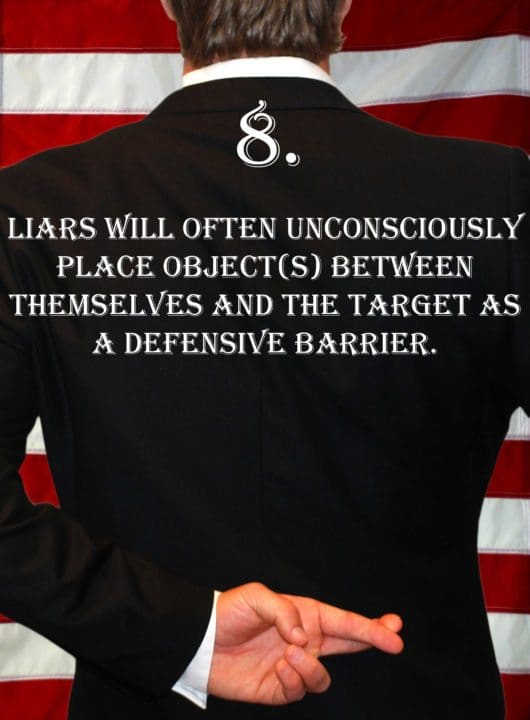
Deception Tip 8:
Liars will often unconsciously place object(s) between themselves and the target as a defensive barrier.
Listen To The Podcast!
E8 – Defensive Barriers – Deception Tips Podcast – Click Here To Subscribe
Podcast Transcript
Hello, and welcome to the Deception Tips Podcast, where you will learn amazing cues to detect deceit that will help you read people like never before. I’m your host, Spencer Coffman. Let’s get started.
Welcome back to another Deception Tip. Today is Deception Tip 8. Last time, we talked about something that you can learn about and it is a telltale sign of deception.
It is something that, when you see it, you know instantly that someone is being deceptive and you can be certain because all of the facts are there. It is too much happening to be explained away by some coincidence, or by something that could be happening in the environment, or some chemical factor. We talked about clusters and patterns of behavior.
Now, we’ve ALWAYS talked about patterns and clusters of behavior. We’ve always mentioned them. It’s always something that I’ve told you, you need to look for and watch out for because when you see them, you can be certain that deception is happening. You can’t ignore multiple signs.
When many, many things happen, it’s too much to be simply a coincidence, or coincidental, or it can’t be explained away anymore. When attorneys see multiple facts, when evidence starts piling up, they start talking a deal.
When you see multiple signs of deception, when a liar starts displaying all of these things, when the unconscious starts winning, prevailing through their body, it’s time for them to start talking the truth. Because if you can see it, you can call them out on that and they will talk the truth.
Otherwise, if you can’t see it, then you’re going to get lied to. It’s as simple as that. You could get hurt. You could get stolen from. They could get away with something. It’s up to you. Do you want to start seeing that? Do you want to be lied to? It’s as simple as that.
Today, we’re going to talk about another sign. Another sign of deception that we’ve touched on before. It’s sort of related to something we talked about a couple of weeks ago. It is something that will allow you to learn more about clusters, and about seeing these clusters, and if you start noticing this, you can start to add it to your repertoire, and now you will have one more sign of deception that you can add to your behavioral cluster vocabulary. When you start seeing all these signs, you put them together, and a cluster of behavior happens. A lie is happening. You can spot that lie.
Deception Tip number 8: Liars will often, unconsciously, place objects between themselves and the target as a defensive barrier. Here it is again. Liars will often, unconsciously, place objects between themselves and the target as a defensive barrier.
Now, of course, it doesn’t have to be objects, it can be singular- objects. Liars can unconsciously place an object between themselves and the target as a defensive barrier.
We talked about this last week when I gave you an example of a person sitting backward in a chair. By backward, you mean that stereotypical. Usually, you see it with a guy, he grabs the chair, walks over to someone, sets it down, spins it and sits down in there, puts his arms over there because he’s going to get to the bottom of something. He’s going to interrogate that person. He’s trying to be cool. He doesn’t want to sit in the chair normally. Whatever the case may be. He’s putting something between himself and another person.
You see it when people pick up their papers off of a table and then they hold them, clutching them to their chest, or their notebook or something. That’s a barrier. Now, in that case, that’s a cluster. Remember what we talked about a couple of times ago when people cover sensitive areas of the body?
So, if they take that notebook, or that portfolio, put it up to their chest, they’re clutching it- number one. That’s for comfort. That’s a sign we haven’t talked about yet — comfort gestures. Number two- if they’re a female especially, they’re covering a sensitive area of the body. Number three- they’re placing that between themselves and the target. That’s three signs right there. Do you think they could be lying? It’s very, very possible. It’s a cluster.
Then you just look for a couple more signs. Obviously, they’ve got to be talking. So, there’s got to be a sign there. They’re breathing. There’s a sign there. See if you can notice anything in there. We’re going to talk about a lot more signs with speech and breathing patterns as the weeks go on. So, keep listening because we’re going to get there.
Another thing, an object could be anything. It could be someone’s hands. We talked about this by covering the genitals. A lot of people, you see it all the time, especially people in suits or security, tend to fold their hands. Not like folding them like interlocking fingers, but like when they place one hand over another. Kind of like when they’re asking for communion but it’s the opposite way.
So, they fold their hands like that, one hand inside of another, and they place those hands right over their groin area. Just kind of standing there. That looks very vulnerable and very insecure. You see that in a lot of security guys, they stand like that, and they wonder why they’re not giving off an intimidating impression. Well, unconsciously, it looks like they’re vulnerable, doesn’t it? And they may be placing something, an object- their hands, in front of themselves, between them and the liar.
Another thing people do all the time is folding their arms. We talked about this weeks ago. When someone folds their arms, they’re placing their arms in between them and the target. They’re placing a barrier there. Now, they may be doing it unconsciously.
They could be doing it for a completely legitimate reason like they’re cold, they need comfort. But comfort could be deceptive behavior. So, all of these things that happen could be something that is a sign of deception, and if you don’t know what that sign means, you could be missing it. And if you don’t know to look for clusters, then you’re definitely missing it, because clusters are what tell you when someone is lying and when someone is not lying.
So, what are some other examples that we can talk about that happen all the time that people put barriers, or objects, in between themselves and another person? It happens all the time.
So how can you tell when it’s happening when someone is lying or when it’s just happening every day? How do you know when it’s being done consciously, with malicious intent, or unconsciously, as a part of the unconscious trying to get the truth out? We’re going to cover all this when we come back.
How would you like to stay sharp when it comes to reading people? Get the Deception Tips email delivered to your inbox each week. Sign up today on spencercoffman.com.
We’ve talked about how the unconscious is always truthful. It is super truthful. It wants to tell the truth. There is no doubt about it. That’s why all of these signs of deception happen when people tell lies. The unconscious is leaking out all of these behaviors and gestures, to tell the truth.
The conscious is self-serving and wants to lie for the benefit itself. Now, of course, people don’t always lie with malicious intent and people aren’t going through life scheming, trying to get the better of everybody else. It happens, but that’s not the general way the human population is. Most people have changed.
Of course, we’re born that way. I say they’ve changed because they’ve matured. When we’re children, everything is about I, me, mine. Look at kids. Look at how it goes. They want stuff. They want everything. They think about themselves. What feels good? What do they like?
But as they mature and get older they start thinking about other people. So, we’re not all going through life being deceptive, but the conscious is deceptive. You’ve just learned to overpower it. You’ve developed more of a moral compass and morality.
Some signs that could happen, is where people place objects between themselves, this is normally done unconsciously when we’re talking about lies, because every sign of leakage is unconscious when we’re talking about lies. But people can do stuff like that consciously. Think of a job interview. How does a typical job interview happen and go down?
Normally, you walk in. If you’re interviewing, you’re sitting behind a desk, looking over someone and their paper, and everything like that, their resume, their credentials. Maybe you’ve got it up on the computer. Maybe you’ve got a hard copy in your hands.
They’re sitting across from you on the other side of the desk, in a chair- probably a softer chair, sunken down. You’ve got a desk between you. If you have a computer, there’s a computer screen with the information that you’re looking at between you.
You also have, if you have a hard copy of their resume, you’ve got that probably propped up probably in front of you. So that’s between you. They have all of that stuff between them and you. In addition, they’ve probably brought some form of paper with them.
Whether it’s a notebook and they’re taking notes, whether they have written down some questions for you. Maybe they have a hard copy of the resume just in case you don’t. They could have any of that with them. Maybe they have a purse and they put it in their lap. They have all of these things between you and them. All of these things are barriers.
These barriers are there already, so it’s not an unconscious barrier. However, it can be thought of as an unconscious barrier in that you don’t think about it. That it’s a barrier. So, it’s unconscious because you aren’t thinking that it’s a barrier. It’s a hidden, unrealized barrier.
This isn’t something that’s deceptive behavior, but it’s still a barrier that’s there that could encourage deception. Or, not really encourage, but make it easier because your conscious is very tricky. We’ve talked about this. It says, “Hey, there’s a desk between us. I can lie and that barrier is there. So, that provides me with a little ease.”
Fortunately, there will be other signs, so there are other signs of deception. And that barrier may be one, but the unconscious isn’t leaking a barrier by putting something else there because something else is already there. This is why a lot of offices, nowadays, have gone to more of an open interview where two people sit in chairs across from each other.
Take a look at psychology. Any movies that you’ve seen or tv shows that you’ve seen or if you’ve been there- look at how group therapy happens. Look at how individual, one-on-one session happens with a psychologist, counselors, or anything like that. People are never behind something.
Usually, the doctor, or psychologist, or shrink, or whoever, or whatever you want to call them, is sitting in a chair. With maybe their legs crossed. Whatever. They’ve got a notebook. They’re taking notes. The person, traditionally, would have been lying on a couch next to them or across from them. Now, they’re sitting in a chair, usually, and people are facing each other.
Look at all of the morning shows, or entertainment tv shows today. Like Ellen, for example. How are they set up? Or even the night shows. Late-night tv. How are people set up? Two chairs, maybe a little table between them, but the table is not right between them, it is back-in between them.
So, it’s kind of off to their sides. The chairs are angled so that people are kind of facing each other and they’re also facing the audience. There is nothing between them and the audience and there is nothing between the two of them. There are no barriers. It is all perceived openness because, unconsciously, barriers are an indicator of deception.
So, when you put barriers between you or someone else, or when someone puts barriers between themselves and you, that can be a little bit of a red flag for people are hiding something. That is the traditional term for the barrier. What does a barrier mean?
Well, when you put up barriers, you’re hiding something. Think back to grade school when you had to take a test and they said, “Everybody take out your barriers” or “barricades” or whatever, and you got out two folders- one on the right, one on the left- and you made like a little cubicle up on your desk. Why? You put up a barrier so no one could cheat on your paper because you were about to take an important test. Barriers indicate hiding, seclusion, and shelter-ness.
So, when people put barriers between one another, unconsciously, like holding up a paper, or maybe putting a notebook there, folding their arms, that is a comfort and it can be a very telltale sign of someone hiding something because typically a barrier is for hiding.
Now that doesn’t always mean that when people put barriers up that they’re hiding, but it is a very good indicator that something may be going on. Just like all of these signs of deception. They’re all a very good indicator that something may be going on. That there could be a lie there, but you need to see it with another behavior. You need to see it with a cluster. And we’re going to say this every single episode.
Clusters are that important. You’re going to get so sick of it but you know what? You’re going to start seeing them and you’re going to start noticing them. And especially, you’re going to start noticing them in yourself. So, don’t freak out because it’s completely normal.
You become more self-aware when you become more aware of others. And that is super important because if you can become more self-aware, now you’ll be much better able to relate with other people. You’ll be able to think about how it happens to yourself and would you want someone else judging every single behavior that you do even if it’s not deceptive.
So, now you’re going to look at other people with much more understanding eyes. You will be able to see them and give them the benefit of the doubt and say “You know what? They’re probably cold.” Or this or that. If you’re a skeptic, you’re going to seek out other signs of behavior and you’re going to notice them and then you can know that they’re lying.
By becoming more self-aware, yeah, it may be a little freaky at first, because you’re going to start noticing all these things that you’re doing and wonder are you lying all the time? But, don’t freak out. Just think about it a little bit more and when you see it on other people, think about how it happened to you.
Were you lying? What was going on? Give them the benefit of the doubt. Start noticing clusters and patterns of behavior on others. Keep listening to this podcast so you can get better at detecting deception.
Once again, I want to that you for listening to the Deception Tips podcast. I encourage you to subscribe to all the feeds, follow all the blogs, take a look at my books and tune in every week for a new Deception Tip.
Video Transcript
Hey guys! My name is Spencer Coffman. Thank you for watching the Deception Tips videos that are all about teaching you how to read people so that you will know if someone is lying to you. You’ll be better able to detect deception by going through all of these signs. By listening to the podcast, by taking a look at all the other information, you will really be able to know exactly what every body is saying.
Today we’re going to cover a sign that is kind of related to some of the other signs that we’ve talked about. This is more of a defensive barrier. It’s something that people use to separate themselves from other people. They kind of put up walls or blockades or barriers so that other people cannot see exactly what’s going on. It’s kind of like we build ourselves a little cubicle or something to ward off the prying eyes.
So, here it is. Deception tip number 8: Liars will often unconsciously place objects between themselves and the target as a defensive barrier.
Now, you notice that they sent objects. Now, it could be an object or objects. It could be one thing or it could be multiple things and, by things, it doesn’t have to be an object. It could be your hands. So, folding your arms is a form of a defensive barrier. That’s why when you ask a bunch of people, “Hey! What does it mean when someone folds their arms?” The stereotypical response is going to be, “Oh. They’re being defensive.” or “They’re withholding and they’re shutting down.” Well, defensive is right in that word. It’s a defensive barrier. They’re blocking.
In addition, you see a lot of the time with like job interviews, or when people have meetings with the boss, or they’re called in the office, usually someone is sitting behind a desk. The other person is in front of the desk, not behind the desk. I mean like on the computer and drawer side of the desk. In front of the desk is on the straight side. The other side, the interviewee side.
That desk is a defensive barrier for both the boss and both the employee or whomever, type of relationship is sitting on each side of the desk. There is something between. You can only see from their chest up. You can’t see their legs, their feet- nothing. You have no idea what is going on below whatever you see behind that desk. That is a defensive barrier.
In addition, if you remember in grade school, you perhaps had to use like your little folders and you put them up, and you put up little barricades on each side of your desk, and it kind of makes like a little wall. So, that when you take a test, no one cheats off of your paper. You set up a defensive barrier so that no one could see what is going on. And this is the same principle that our unconscious uses when inputting these defensive barriers together.
Now, the reason that this happens is the same thing in elementary school when you do it to prevent prying eyes from seeing your answers, or from seeing what you put down, what you’re doing. When you do it unconsciously, like when a liar does it- if they put a notebook in front of them, they fold their arms, they hide behind a desk, or something- they are putting that defensive barrier for a reason that they don’t want other people to see what is going on on their body. It is something like they’re feeling vulnerable.
If you remember a few videos ago, we talked about covering the genital areas or covering up private areas, because it’s a feeling of vulnerability. A liar may feel exposed. And, it typically happens when questioned, when they are prodded. It’s like a confirming behavior of lying. It’s something that is a result of being pushed or being pressed a little further in that lie. And this one, where it’s just a defensive barrier, this could happen during the lie. It could happen after the lie. It could happen when they’re pressed on it. It could happen right at the beginning.
They could set up a defensive barrier, such as folding their arms and kind of turning away a little bit and then start telling their lie. And the reason they do this is because now my hands, you can’t see them very well. So, I could be moving my fingers and fidgeting or doing something to help ease the tension of telling a lie, but it’s hiding. It’s defending. You’re not being able to see that.
So, keep an eye out for defensive barriers because they can be anything. Anything that goes between you and whomever you’re talking to- the target, and the liar- anything that goes between there. Whether it’s a desk, a folder, a notebook, someone’s hands, anything could be a potential defensive barrier. So, watch out for that and keep your eyes open for other signs so that you can put clusters and patterns of behavior together.
If this is your first time watching these videos I’d love to have you subscribe to the channel on YouTube. It’s all about teaching you how to read people and detect deception so that you will know exactly what every body is saying. Feel free to comment on the videos as well. In addition, if you’d like some more information we’ve got books, podcasts, blog posts, and all kinds of stuff available on spencercoffman.com that is dedicated to teaching you exactly what every body is saying.
Until next time.


